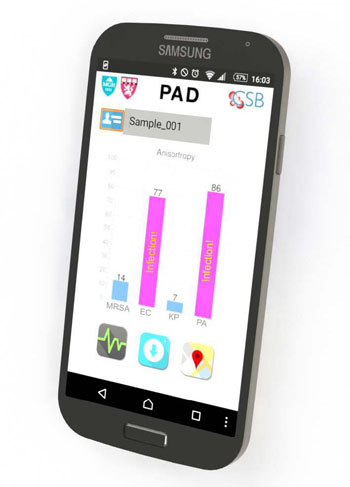Microbiologists Display Prototype of Rapid Bacteriological Test Device
By LabMedica International staff writers
Posted on 16 May 2016
A prototype rapid diagnostic device was shown in a proof-of-concept study to identify pathogenic microorganisms with accuracy comparable to that of bacterial culture but with much shorter turnaround time.Posted on 16 May 2016
Investigators at Massachusetts General Hospital (Boston, USA) based their device on the principle of fluorescence anisotropy, the phenomenon where the light emitted by a fluorophore has unequal intensities along different axes of polarization. Their "Polarization Anisotropy Diagnostics" (PAD) device uses changes of fluorescence anisotropy when detection probes recognize target bacterial nucleic acids.

Image: A smartphone readout from the Polarization Anisotropy Diagnostics (PAD) system reveals the pathogens responsible for an infection and factors such as antibiotic resistance (Photo courtesy of Dr. Chen-Han Huang and Dr. Ki Soo Park, Massachusetts General Hospital).
The compact PAD device included a disposable cartridge for sample preparation and multi-well detection. To perform the test bacterial RNA was extracted from a sample in the disposable plastic cartridge. Following polymerase chain reaction amplification of the RNA, the material was loaded into a two-centimeter plastic cube containing optical components that detected target RNAs based on the response to a light signal of sequence-specific detection probes. These optical cubes were placed on an electronic base station that transmitted data to a smartphone or computer where the results were displayed.
The assay was fast (two hours) compared to two to three days for classical culture. When applied to clinical samples obtained from interventional procedures, the PAD determined the overall bacterial burden, differentiated bacterial species, and identified drug resistance and virulence status.
"This prototype still needs several improvements, including building a self-contained system housing all functions, further reducing the current assay time to less than one hour and expanding the panel of probes to even more pathogens and resistance factors," said senior author Dr. Hakho Lee, associate professor of radiology at Massachusetts General Hospital. "But we can see three immediate applications for a system that can provide such rapid and accurate results - quickly diagnosing a patient's infection, determining whether antibiotic-resistant bacteria are present in a group of patients, and detecting bacterial contamination of medical devices or patient environments."
The PAD device was described in the May 5, 2016, online edition of the journal Science Advances.
Related Links:
Massachusetts General Hospital













